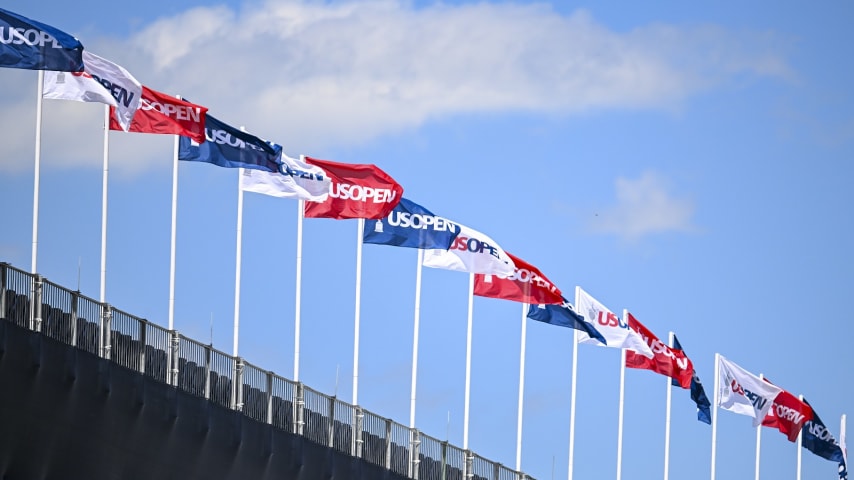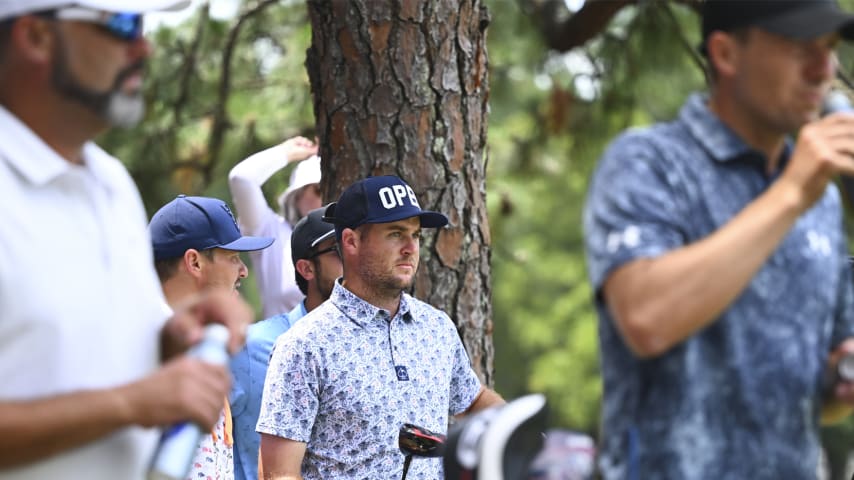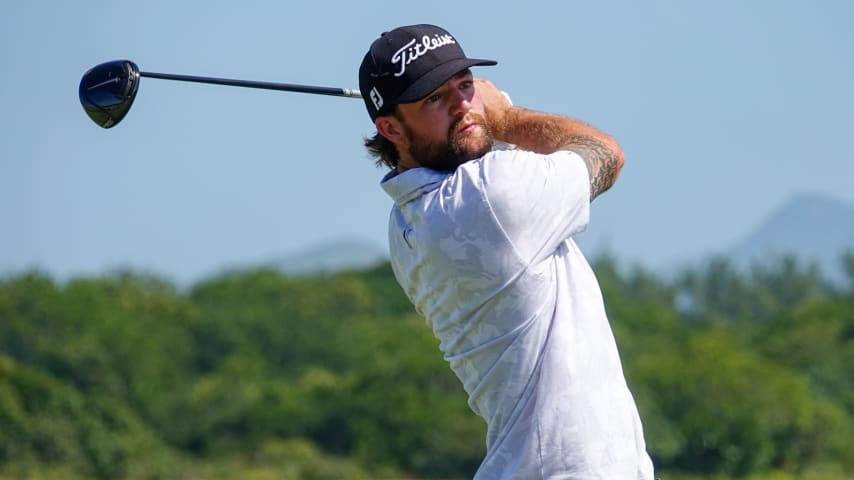Retrospective: 25 years after Payne Stewart’s U.S. Open victory at Pinehurst, week’s echoes endure
9 Min Read

The best moments from Payne Stewart’s career
Written by Kevin Robbins
When Payne Stewart set out to play the 1999 U.S. Open, he was a man who respected his limits. He averaged 266.7 yards off the tee that season. He ranked 153rd in driving distance. None of it mattered to the sweet swinger from Springfield, Missouri. Stewart resisted the emerging trend on the PGA TOUR of lashing the ball as far as possible, consequences be damned. He was, at the age of 42, a relic.
Pinehurst No. 2 looked that year like it encouraged violence. Many players saw, in the rambling Donald Ross classic, a course that forgave, and even invited, length over precision. The fairways were generous. The rough was light. The pine needles outside the corridors were of no significant concern. All eyes that week were on David Duval, Phil Mickelson, Davis Love III, Vijay Singh and Tiger Woods. The bombers. The young.
Stewart created a different plan. The 10-time PGA TOUR winner brought his coach, Chuck Cook, to Pinehurst for an early assessment after a missed cut in Memphis. They charted the vexing contours Ross had created in the North Carolina sandhills in 1907. They wrote notes in a yardage book in their first walk around the course, noting in meticulous detail the spots around the domed greens where salvation was possible and where it likely was not. Stewart wasn’t thinking a whole lot about tee shots. He was mulling approaches, pitches and chips. He didn’t even bother to bring his driver.
He opened the championship with a 2-under 68, a stroke behind the leaders. He never once found himself too far out of position or over a shot he hadn’t prepared to execute. He picked apart a golf course that welcomed all forms of strategy – big drives, long irons to the fairways, power and prudence. Stewart had made his choice. It put him in a tie for fifth with three rounds to go.
Many in the field had played No. 2 before 1999, but not in USGA conditions. The TOUR Championship had been there a couple of times in the early 1990s. The North & South Amateur was a mainstay at No. 2. The only USGA championship to have been there was the 1962 U.S. Amateur, the one after reigning champion Jack Nicklaus turned professional. The USGA prepared No. 2 at a startling 7,051 yards for that tournament, making it the longest course to date in 104 years of national championships and presumably the kind of place that favored young, limber and supple athletes.
The results justified the impression. Only one contestant older than 30 advanced to the quarterfinals. Reporting from Pinehurst that week for Golf Journal, Frank Hannigan overheard someone call No. 2 “the slaughter of the ancients.” Labron Harris Jr. of Oklahoma won. He was 20. But he didn’t triumph with long, mesmerizing drives; Harris did it with finesse, touch and uncluttered imagination around the nefarious Ross greens. He even putted out of bunkers.
In 1999, the USGA presented No. 2 at 7,175 yards to a par of 70. It was the third-longest course in U.S. Open history. Players rarely spoke of U.S. Open setups as an invitation to pound driver at every opportunity. But the event had never been to Pinehurst before. The USGA encouraged chances to score, widening fairways by up to seven yards beyond the typical. The preparation team sought to emphasize the tightly mown green surrounds as the keys to scoring well.
As the week went on, Stewart and the rest of the players were getting a sharper sense for how shots spilled from the edges of the perniciously humped greens, the emerging crucible of the 99th U.S. Open. Woods saw his approaches carom from the sides and amble 20 yards away, sometimes into the wispy pine straw, like a flushed dove. “Very severe,” he noted. Mark O’Meara said he thought imagination and creativity would supplant the power game, and “I think that’s wonderful.” Nicklaus saw a golf course early in the week that struck him as open to birdies and equitable. Colin Montgomerie, the Scotsman who typically played well in the U.S. Open and had finished second in 1997, said he wasn’t even looking at the flagsticks on No. 2. He said he aimed at the middle of the green on every approach, “because if you start attacking this type of course, you’re in trouble.” He was only 36 that summer. But he was an old soul. Like Stewart, he recognized his limits, and distance off the tee was one of them.
Stewart had spoken that week of an “inner sobriety” in his life. He was, after a long career that included victories at the 1989 PGA Championship and the 1991 U.S. Open, keenly aware of the benefits of a quiet mind and sound judgment. He once lacked both. But he knew more in 1999 about himself and about smart golf. He endured a long slump between 1992 and 1998, when he surprised even himself by nearly winning his second U.S. Open at Olympic Club. He finished in second to Lee Janzen, worked hard in the off-season and won early in 1999 at Pebble Beach. He was a different man and player. He played within himself in life and golf.

The best moments from Payne Stewart’s career
Stewart went out early Friday for the second round, in the thin light of daybreak and the long shadows of the pines. A breeze rose. The ground dried.
The theme of the day became resilience. Pinehurst turned vicious in stout winds under a relentless sun. Approaches that held near the flagstick in the first round bounced away in the second. The edges of the greens yellowed. Stewart shot 69. It tied for the lowest score of the second round, a stroke under par on a difficult day in North Carolina. Mickelson and Duval tied him for the aggregate lead at 3-under 137. Woods was two behind, with Singh and Hal Sutton. Stewart’s caddie, Mike Hicks, had pulled only one club for Stewart through two rounds. He was carrying a golf bag for a man in control of his mind and movement. All Stewart wanted from his caddie was the yardage and the wind. Every swing looked the same. Every shot hit its spot. Every stride seemed to point the player and caddie toward a destination they didn’t dare mention but sensed.
“He’s on autopilot,” Hicks thought.
Stewart wore a flat cap and plus-fours in Carolina blue for a Saturday scented with the approach of rain. Three days of USGA scrutiny had firmed the greens, grown the once-docile rough, and turned No. 2 into a savage. The average score on Saturday was 75.97. Only Steve Stricker broke par, and only then by a shot. Stewart shot 72. It was good enough to put him in the final group Sunday with 29-year-old Phil Mickelson. A bomber. A youth. Sunday, June 21, felt like an epic in the making.
Here was Stewart, a man supposedly past his prime. Here was Mickelson, a man supposedly destined with his length and touch to win U.S. Opens. Both played exceptional golf on that cool and misty afternoon. Stewart stuck to his plan. He and Mickelson were tied for the lead through 15. Stewart holed a long, twisting putt for a spirit-filling par on the 16th. Mickelson missed his from 8 feet. Stewart followed that with a center-cut 4-footer for birdie on the par-3 17th. Mickelson missed from 6 feet. The galleries swelled. Stewart held a one-shot lead on the 18th tee.
His drive on the par-4 final hole drifted right. Mickelson ripped his right up the fairway.
It was at this moment that age confronted youth with the highest stakes. The indelible final scene at the 1999 U.S. Open earned its place in golf lore for actions taken and options dismissed. The USGA had wanted to present players with options from the shorter rough on No. 2, but Stewart convinced himself he had only one. His ball was in right rough, in the worst lie he’d encountered through 71 holes. It missed the intermediate cut by four inches. Stewart calculated the yardage to the cross bunkers short of the green. A younger Stewart might’ve tried to reach the green. He now was a man who knew better. He slashed an 8-iron shot to 78 yards in the fairway, two paces short of the bunkers, “the most boring play in sports,” as Stewart had called the back-into-position shot at the PGA Championship at Shoal Creek in 1990.
Bells rang faintly at a church in the distant village. Ron Crow, the walking scorer with Stewart, heard the throaty welcome of the gallery and thought: “The ground is vibrating.” The bells had quieted by the time Stewart watched Mickelson miss his putt for birdie. The ground ceased to vibrate by the time he took his stance over his ball. The massive gallery, sensing the weight of the moment, went silent.
Stewart pulled his putter back.
The many retrospectives of the 1999 U.S. Open will note the tears Stewart shed after his 15-foot putt to win scampered up a modest slope and tumbled into the hole. They will honor the way Stewart took Mickelson’s face in his hands and told him that the impending birth of his first child would be far more important than a lost golf tournament. They might even mention Stewart’s gesture of sportsmanship that fall at the Ryder Cup matches at Brookline, where he conceded his final singles match to Montgomerie because the U.S. already had secured the cup.

Fred Couples remembers Payne Stewart waking up Ryder Cup team with boom box
All true. All important.
Hours after winning at Pinehurst, Stewart and his caddie barreled through the night, Stewart sipping Bud Lights, with a police escort up front, lights whirling. They were driving to Mebane, where Hicks lived, to play the next morning with Sutton, Fred Couples and Paul Azinger in a charity outing at Mill Creek Golf Club. Stewart and Hicks arrived at midnight. They drank Cristal and moonshine from the trophy. It was around 4 a.m. when Stewart and Hicks, sitting on his kitchen counter, took stock of the moment: the plan, the wisdom of the back-into-play shot on the 72nd hole, the drive to Mebane, the taste of the Cristal, the promise of more majors.
Stewart died four months later. He and five others perished aboard a private aircraft that depressurized on ascent from Orlando, Florida.
Stewart was 42 years, 4 months and 21 days old when he won the first U.S. Open at Pinehurst No. 2. He became the fifth-oldest winner of the national championship. He remains the last player in his 40s to win a U.S. Open. The USGA wanted to give every style of play a chance to win in 1999. Pinehurst No. 2 was just the kind of course to welcome that decision.
“There used to be a void in my life,” Stewart told reporters in his post-championship press conference.
“The peace I have now is so wonderful,” he said. “I don’t understand how I lived so long without it.”

The statue of Payne Stewart in his iconic victory pose at Pinehurst Resort and Country Club. (Streeter Lecka/Getty)
On his last night as a winner, he cried like a baby. And he celebrated like a kid.






